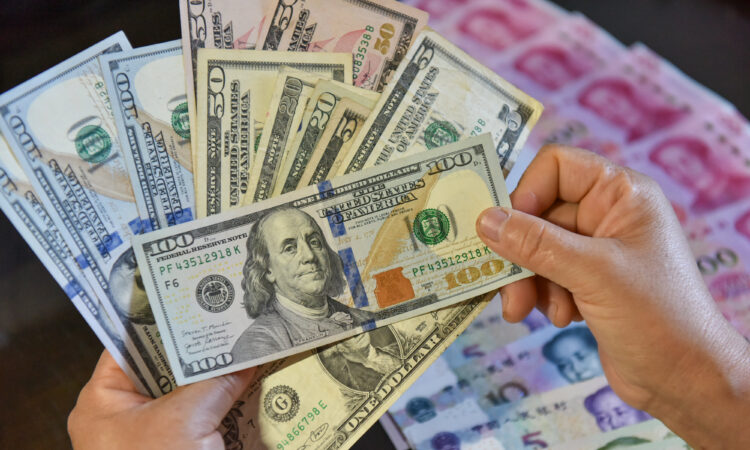
In this photo illustration, the man is holding several U.S. dollar bills with some Chinese yuan in the background.
Sopa Images | Lightrocket | Getty Images
The dollar slipped from a fresh three-month high on Wednesday as investors consolidated gains following the previous session’s hotter-than-expected U.S. inflation report that pushed back bets on a first Federal Reserve rate cut to some time in the middle of the year.
Since Tuesday’s data showed the U.S. consumer price index (CPI) gained 3.1% in January from a year earlier, versus an expected 2.9% rise, fed funds futures have priced in no Fed cut in March and a nearly 80% chance of easing at the June meeting, according LSEG’s rate probability app.
Futures are also pricing in about three rate cuts of 25 basis points each this year.
The dollar index , which measures the U.S. currency against six other majors, eased 0.1% to 104.97, having touched a fresh three-month high of 104.97.
“The U.S. dollar could have a bit of room left to run up slightly more through the end of Q1 of this year,” said Helen Given, FX trader at Monex USA in Washington.
“Since the U.S. economy appears to still be remarkably resilient, we could see further rhetoric from Fed officials that add a bit of juice for the U.S. dollar,” she said.
“I’ve started to use the term ‘American expectionalism’ when discussing the picture for the U.S. dollar, as outperformance of the U.S. economy over its peers over the last year has become almost so commonplace we’ve come to expect it.”
Sterling was down 0.4% at $1.2541, after briefly touching an eight-day low as data showed UK inflation did not accelerate in January as expected. This may relieve some of the pressure on the Bank of England (BoE) to keep rates where they are for longer.
UK inflation stood at an annual rate of 4.0% in January, unchanged from December. Economists polled by Reuters had forecast an increase to 4.2%.
Money markets see a 51% chance of a BoE rate cut in June and a 75% chance of one in August, according to LSEG’s Refinitiv app.
Meanwhile, the dollar weakened against the yen after Japan’s top currency officials warned against what they described as rapid and speculative yen moves.
The greenback eased 0.1% to 150.585 yen , not too far from a three-month high reached against the Japanese currency on Tuesday. The dollar has added about 10 yen in price since the start of this year.
“We are watching the market even more closely,” Japanese Finance Minister Shunichi Suzuki told reporters. “Rapid moves are undesirable for the economy.”
Asked whether authorities could intervene in the currency market, Suzuki left his office without a word.
Earlier, Japan’s top currency diplomat Masato Kanda said the nation would take appropriate actions on forex if needed.
Japan intervened in the currency market three times in 2022 when the yen plunged to 32-year lows near 152 yen to the dollar, conducting rare dollar-selling, yen-buying intervention.
Elsewhere, the euro inched up 0.1% to $1.0720 amid a slew of euro zone economic data. It earlier touched a fresh three-month low of $1.0695.
Euro zone employment rose 0.3% quarter-on-quarter and by 1.3% year-on-year in the fourth quarter. According to a Reuters poll, employment had been expected to rise 0.2% quarter-on-quarter and 1.1% year-on-year.
Data also showed economic growth in the region was flat in the last three months of 2023 against the previous quarter and up 0.1% against the same period of 2022.
In cryptocurrencies, bitcoin rose 4.1% to $51,578, hitting its highest since December 2021 above $52,000.




